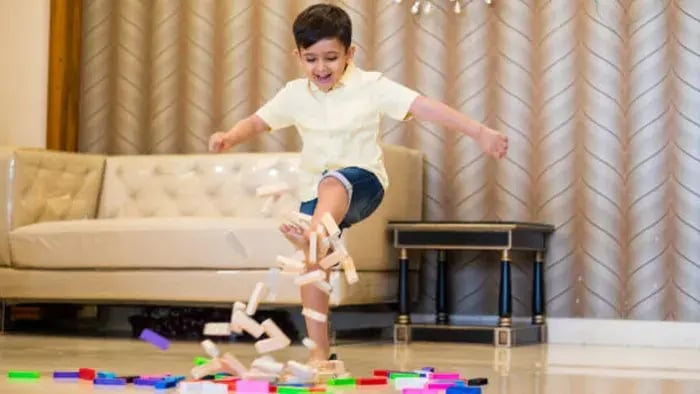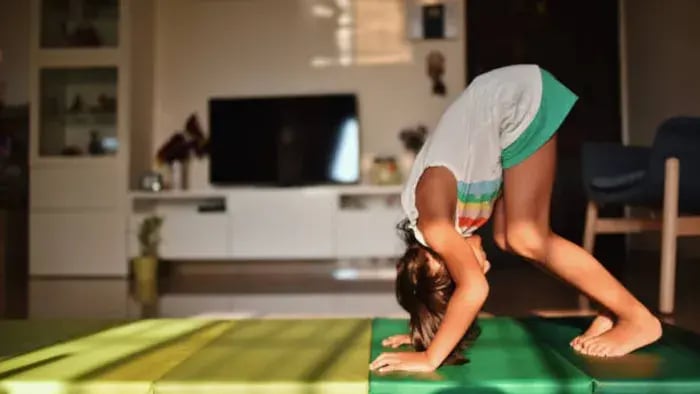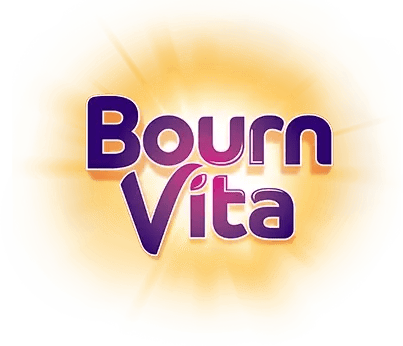- Animal Obstacle Course
- Rolling Ball Maze
- Balloon Balance Walk
- Laundry Basket Races
- Hopscotch With a Twist
- Giant Shape Jumps
- Parachute Play With Bedsheet
Introduction
Big movements matter just as much as small ones in early childhood. For preschoolers, running, hopping, jumping, and climbing are not just ways to burn energy; they’re building blocks for strength, balance, and coordination. Gross motor activities help children gain control over their bodies, so everyday tasks like walking up stairs, throwing a ball, or even sitting still get easier with time.

What makes these activities even more valuable is how they fit into a child’s daily routine. Whether it’s hopping like a frog across the living room or balancing on a line drawn with chalk outside, every significant movement boosts their physical confidence. It also regulates their mood, improves sleep, and helps them focus during learning time.
You don’t need a gym or a structured sports class to make a difference. With simple, playful movement games that use space and imagination, you can support your child’s growth right at home. It’s about creating moments where they can move freely, explore safely and have fun while their bodies get stronger and more coordinated.
7 Amazing Top Gross Motor Activities for Preschoolers That Get Them Moving

Preschoolers are bundles of energy, and gross motor activities are the perfect way to harness that energy into movement. These activities help young children build muscle strength, balance and coordination, and body awareness. Gross motor skills involve the big muscles in the arms, legs, and torso, and strengthening them supports better posture, stamina, and overall physical development.
Here are seven fun and easy gross motor activities that bring movement, fun and learning together.
Animal Obstacle Course
Set up cushions, chairs or even towels as obstacles and ask your child to crawl like a bear, hop like a frog, slither like a snake, or waddle like a duck. As per a study published in, Int J Environ Res Public Health. 2021, this type of imaginative movement helps build strength, flexibility, and coordination, and they’ll be entertained while getting a full-body workout.
Rolling Ball Maze
Use masking tape or pool noodles to create paths on the floor and ask your child to roll a ball through the track using their hands or feet. As per a study published in, Int J Environ Res Public Health. 2020, this activity builds coordination and core strength while they’re focused and active.
Balloon Balance Walk
Have your child hold a balloon between their knees and try to walk from one point to another without dropping it. Research published in Cochrane Database Syst Rev. 2019, states that this helps with balance, focus, and leg control. You can add variations by having them walk backwards or around obstacles for a challenge.
Laundry Basket Races
Put your child in a laundry basket and have them push it across a smooth floor with their legs, or get a sibling to pull them along. A study published in Sports Med Open. 2020 suggests that this builds upper and lower body strength and teamwork. You can even add checkpoints or make it a timed race for extra fun.
Hopscotch With a Twist
Draw a hopscotch pattern outside with chalk or inside with tape. Instead of just hopping through, add prompts like spinning in a circle, jumping on one foot twice, or touching your toes. According to a study published in J Int Soc Sports Nutr. 2015, this activity helped build muscle control and counting, and kept it exciting.
Giant Shape Jumps
Place large shapes on the floor and have your child jump from one to another. Call out the shape and a movement: “Jump on the triangle and clap!” as per a study published in BMC Pediatr. 2025, this combines gross motor play with shape recognition, listening, and balance.
Parachute Play With Bedsheet
Hold the corners of a large bed sheet with your child and make waves, pop soft toys up and down, or have them crawl under it as it moves. According to a study published in Int J Environ Res Public Health, 2021, this activity builds teamwork, upper body strength, rhythm, and timing.
Conclusion

Encouraging preschoolers to move with purpose and joy is the best gift you can give them. These gross motor activities are more than just play – they support your child’s physical, emotional, and cognitive growth. They help your little one stay active, explore their body, and build confidence all while having loads of fun. Whether indoors or outdoors, the key is to keep it light, creative, and consistent. So roll out the mat, clear a little space, and watch your child grow stronger and happier with every jump, crawl, and wiggle.
Her love for storytelling began with reading her grandfather’s speeches, where Tarishi saw the power of words in creating lasting memories. Combining her passions for food and writing, she has turned her life into a fulfilling path of sharing stories that celebrate flavours and how food brings communities together.
The views expressed are that of the expert alone.
The information provided in this content is for informational purposes only and should not be considered a substitute for professional medical advice, diagnosis, or treatment. Always seek the advice of your physician or another qualified healthcare provider before making any significant changes to your diet, exercise, or medication routines.
References
https://pmc.ncbi.nlm.nih.gov/articles/PMC11921545/
https://pmc.ncbi.nlm.nih.gov/articles/PMC4658772/
https://pmc.ncbi.nlm.nih.gov/articles/PMC7158966/
https://pmc.ncbi.nlm.nih.gov/articles/PMC6360922/
















